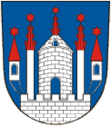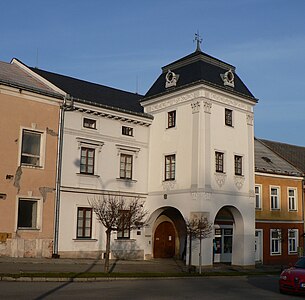Zábřeh
| Zábřeh | ||||
|---|---|---|---|---|
|
||||
| Basic data | ||||
| State : |
|
|||
| Region : | Olomoucký kraj | |||
| District : | Šumperk | |||
| Area : | 3458 ha | |||
| Geographic location : | 49 ° 53 ' N , 16 ° 52' E | |||
| Height: | 285 m nm | |||
| Residents : | 13,589 (Jan 1, 2019) | |||
| Postal code : | 789 01 | |||
| structure | ||||
| Status: | city | |||
| Districts: | 5 | |||
| administration | ||||
| Mayor : | František John (as of 2012) | |||
| Address: | Masarykovo náměstí 6 789 01 Zábřeh |
|||
| Municipality number: | 541354 | |||
| Website : | www.zabreh.cz | |||
Zábřeh (German Hohenstadt an der March ) is a city in the Czech Republic . It is located twelve kilometers southwest of Šumperk on the Moravská Sázava and belongs to the Okres Šumperk .
geography
Zábřeh is located 285 m above sea level. M. at the eastern foot of the Zábřežská vrchovina ( Hohenstädter Bergland ) on the left bank of the Moravská Sázava and is traversed by its tributary Krumpašský potok. To the east of the city lies the March river plain . The Silnice I / 44 from Mohelnice to Bludov and the secondary state roads 315 from Lanškroun to Úsov and the 369 to Vyšehoří run through Zábřeh . The town lies on the railway line from Česká Třebová to Olomouc and the branching route to Šumperk .
Neighboring towns are Rovensko in the north, Postřelmov in the northeast, Lesnice in the east, Leština and Rájec in the southeast.
history
The first written mention of Zábřeh comes from the year 1254, its owner was Sulislaus von Hohenstein ( Sulislav ze Zábřeha ) at the time . In 1275 city rights were granted. The Hohenstein family ( ze Zábřeha ) was at that time the most important aristocratic family in the area, along with the Hrabischitz on Moravská Třebová . The existence of a castle has been documented since 1289. In 1343 the Sternbergers acquired Hohenstadt, the next owners were the Krawarn and from 1442 the Tunkl von Brünnles . Under the Tunkl the rule was united with Hochstein and Brünnles . Fish ponds were created on the March and Moravská Sázava , of which only the Oborník ( castle pond ) is still preserved and regulates the river including the Krumbach. Since Georg von Tunkl was a supporter of King Georg von Podiebrad , there were fights with the Hungarian King Matthias Corvinus near Hohenstadt in 1468 . In 1510 Heinrich / Jindřich Tunkl sold Hohenstadt with Brünnles and Eisenberg an der March to Nikolaus Trčka von Lípa , who three years later sold the Hohenstadt dominion, which consisted of 35 villages, to Ladislav von Boskowitz . Under the Boskowitz the rule became rich. In 1581 the Bohemian Brothers founded the first school in Hohenstadt. In 1589, Johann "Šembera" von Boskowitz and Černahora ( Jan Šembera Černohorský z Boskovic ) transferred the Hohenstadt rule to his nephew Ladislav Velen von Zerotein . Since he was on the side of the rebels in 1618 , his goods were confiscated by the Emperor after the Battle of the White Mountain in 1622 and transferred to the governor of Bohemia, Karl von Liechtenstein . Under the Liechtensteiners , the castle was partially renovated in 1661 and expanded and baroque in 1727–1736 through alterations and additions.
After the abolition of patrimonial Hohenstadt became the seat of a political district and a judicial district in 1850. The relevant offices were housed in the castle, which the city had acquired from the Liechtensteiners in 1848. As early as 1842 the construction of the railway from Olomouc to Prague was started by the Imperial and Royal Northern State Railways and in 1845 the first train passed through Hohenstadt. In 1871 the branch line to Mährisch Schönberg was opened, making Hohenstadt a railway junction. Industrialization then began. Important companies were cotton spinning, twisting, red yarn dyeing, silk weaving, machine shops, a nail factory and a brewery.
In 1890 there were 2,940 people in Hohenstadt, 2,082 of them were Germans. After the establishment of Czechoslovakia in 1918, Hohenstadt received the official place name Zábřeh . Around 1920 Krumpach was incorporated and in 1930 Hohenstadt had 5389 inhabitants. As a result of the Munich Agreement , Zábřeh / Hohenstadt was incorporated into the German Reich in 1938 and was the seat of the Hohenstadt district , district of Troppau , in the Reichsgau Sudetenland until 1945 . After the Second World War it fell back to Czechoslovakia and was again renamed Zábřeh . In 1945/46 the German population was expelled .
Demographics
| year | Residents | Remarks |
|---|---|---|
| 1890 | 2,940 | thereof 2,082 Germans |
| 1900 | 3,011 | predominantly German residents |
| 1930 | 4,827 | thereof 2,920 Czechs and 1,803 Germans (in the municipal boundaries of 1939: 6,247 inhabitants) |
| 1939 | 6,554 |
Say about the devil's plow
To the east of the city, several large fish ponds were created in the March plain with the city pond and the large and small Zadworschitzer ponds ( Závořické rybníky ) at the end of the 15th century . Because of the heavy burdens imposed on the subjects for the construction and maintenance of the ponds, an uprising broke out in 1494. Rebelling subjects attacked Georg the Elder of Tunkl and fatally injured him. Subsequently, the legend arose that after his death, Tunkl, hitched to a plow under the scourge of the devil, plowed the bottom of the Zadworschitz ponds every night as punishment.
Community structure
To town Zábřeh include the districts Dolní Bušínov ( Niederbuseln ) Hněvkov ( Nefke ) Pivonín ( Piwonin ) and Václavov ( Watzelsdorf ) and the local positions Krumpach, Levenov ( Löwenau ) Ráječek ( small Rasel ) Rudolfov ( Rudolf Thal ) and Skalička ( Skalitz ).
Town twinning
-
 Handlová , Slovakia
Handlová , Slovakia -
 Ochsenfurt , Germany
Ochsenfurt , Germany
Attractions
- Hohenstadt Castle was built on the site of a Gothic castle from the 13th century in the Renaissance style. After a renovation in 1661, it was converted to Baroque style in 1727–1736 and sold to the city in 1849 by the Liechtensteiners.
- The parish church of St. Bartholomew was built in 1756 according to a design by Domenico Martinelli , only after his death. It has a rich baroque interior with paintings by the painter Thaddäus Supper from Müglitz .
- On the market square there is a Marian column ( plague column ) from 1713 and an Empire fountain from 1829.
- The Barbarakirche in the old cemetery was built by the Brothers' Union in the 15th century and rebuilt in 1772. In it were John Amos Comenius and his first wife Magdalena Vizovská married.
- The house under the arbors is a town monument and birthplace of Magdalena Vizovská. It serves as the city museum and, in addition to city history expositions, houses an exhibition on Jan Welzl.
- Parish Museum
- Jan Welzl's statue in front of the train station
- Tunkl-Hof, today the municipal gallery
- Evangelical Church, founded by the Brass family
- Sights in Zábřeh
Jan Welzl statue
Personalities
- Honorary citizen
- Karel Lukas (1897–1949), Czechoslovak general and victim of communism in 1947, he received his honorary citizenship, which was revoked in 1950, back in 1990
- Jan Welzl (1868–1948), 2000, posthumously
- sons and daughters of the town
- Georg Vetter (1536–1599), hymn poet
- Magdalena Vizovská (around 1600–1622), first wife of the pedagogue and brother bishop Johann Amos Comenius
- Moritz Fröhlich von Feldau (1825–1896), railway contractor
- Wilhelm Brass (1819–1897), entrepreneur and textile manufacturer, inventor of Turkish red
- Jan Welzl (1868–1948), polar explorer
- Ctirad Kohoutek (1929–2011), composer, music pedagogue and scholar
- Luboš Kohoutek (* 1935), astronomer
- Jaroslav Mostecký (* 1963), author
- Ondřej Bank (* 1980), ski racer
- Robin Wagner (* 1993), cyclist
literature
- Joachim Bahlcke , Winfried Eberhard, Miloslav Polívka (eds.): Handbook of historical places . Volume: Bohemia and Moravia (= Kröner's pocket edition . Volume 329). Kröner, Stuttgart 1998, ISBN 3-520-32901-8 , p. 198 f.
Web links
- City website
- Parish Museum (Czech)
- City Museum Under the Arbors (Czech)
Individual evidence
- ↑ Český statistický úřad - The population of the Czech municipalities as of January 1, 2019 (PDF; 7.4 MiB)
- ↑ Hohenstadt . In: Meyers Großes Konversations-Lexikon . 6th edition. Volume 9, Bibliographisches Institut, Leipzig / Vienna 1907, p. 450 .
- ↑ a b Michael Rademacher: German administrative history from the unification of the empire in 1871 to the reunification in 1990. Hohenstadt district. (Online material for the dissertation, Osnabrück 2006).






